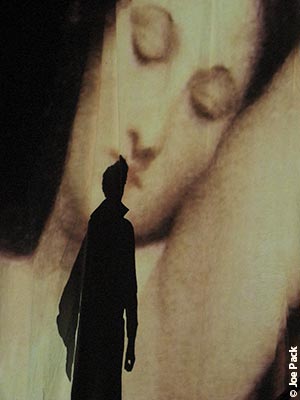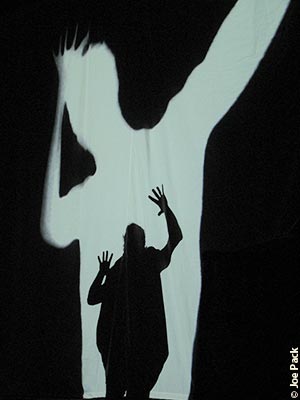| The show began with an illuminated backdrop screen silently summarizing the story for the audience in order to clarify the over-extravagant quality of singing that was to follow. The basic idea of the story is: the part-divine nymph Galatea (Rosie Coad) and the charming youthful shepherd Acis (Thomas Macleay) fall in love with each other, but the Cyclops Polyphemus (David Roth) also falls in love with the nymph. Galatea carelessly refuses his advances and her dismissal enrages him, consequently causing him to retaliate against, and ultimately conquer, his mortal rival, Acis. The resulting sorrow shared by his love, Galatea, and his friend, Damon (performed by John Bacon), was sincerely tragic until Galatea succeeds with her plea to the gods to immortalize her beloved by metamorphosing him into a mountain stream. The story, with its reflections on the human spirit, its strength and struggle for love and truth, brings together the past and the present with the magic of the divine.
Some technical distractions with the lighting and visual/video effects were apparent throughout the show, but were overshadowed by strong performances in particularly spectacular scenes. The duet "Happy we", between Acis and Galatea, was a charming end to the first act, with great chemistry between lovers as they sang and danced about with one another. There was also an amazing scene where the visuals worked exceptionally well with the staging: a scene where Polyphemus’ rage was evermore commanding as the actor, David Roth, stood high upon a chair while his silhouette shadowed against the back-drop screen which was a projection of a menacing eye illuminating over him. And yet another brilliant delivery followed, this time from Macleay: in his response to Damon’s warning ("Consider, fond shepherd"), Acis sang the words “when beauty is the price, no mortal fears death” in a truly captivating and mesmerizing performance.
Recognizing the interconnectedness of theatre with many other art forms — including, in this case, traditional and modern mediums — Acis and Galatea was a major success for the Fringe festivals’ first-ever opera attempt. Its theatrical interaction between the characters was heightened by elaborate costuming, lighting, visual effects, and ultimately with the presence of period instruments. Educating and entertaining, artists like these are freshening-up preserved art forms and validating opera’s relevance to the present.
|
|
|



